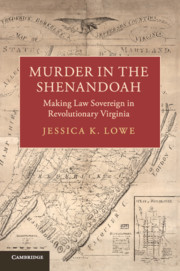Book contents
- Murder in the Shenandoah
- Studies in Legal History
- Frontispiece
- Murder in the Shenandoah
- Copyright page
- Dedication
- Contents
- Figures
- Acknowledgments
- Introduction
- 1 The Facts of the Fight
- 2 The Making of a Republican Judge
- 3 Examination Class, Procedure, and Local Courts in Crane’s Virginia
- 4 The Bloody Code and the Logic of Legal Reform
- 5 Indictment
- 6 Crane’s Trial and Its “Imperfect” Verdict
- 7 “That Stigma on My Character”
- 8 Murder or Manslaughter?
- 9 Pardon Request
- Conclusion
- Index
8 - Murder or Manslaughter?
Crane’s Special Verdict at the General Court
Published online by Cambridge University Press: 01 February 2019
- Murder in the Shenandoah
- Studies in Legal History
- Frontispiece
- Murder in the Shenandoah
- Copyright page
- Dedication
- Contents
- Figures
- Acknowledgments
- Introduction
- 1 The Facts of the Fight
- 2 The Making of a Republican Judge
- 3 Examination Class, Procedure, and Local Courts in Crane’s Virginia
- 4 The Bloody Code and the Logic of Legal Reform
- 5 Indictment
- 6 Crane’s Trial and Its “Imperfect” Verdict
- 7 “That Stigma on My Character”
- 8 Murder or Manslaughter?
- 9 Pardon Request
- Conclusion
- Index
Summary
- Type
- Chapter
- Information
- Murder in the ShenandoahMaking Law Sovereign in Revolutionary Virginia, pp. 142 - 162Publisher: Cambridge University PressPrint publication year: 2019



